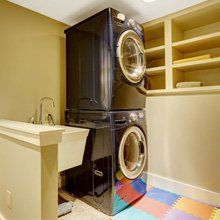
Do-It-Yourself Appliance Repair Work
Want to repair your appliance by yourself, but don't know where to start? Aplus Appliance Repair Parts & Service provides FREE advice to do-it-yourselfers, so view our tips below and contact us with any questions.

Washing machine tips
Check washer water fill hoses for cracks, blisters, corroded fittings and leaks. Cracks are a sign of aging and a breakdown of the rubber. Blisters signal a rupture in the inner lining of the hose, which means the hose may burst at any time. Corroded fittings mean the hose has leaked or is leaking now.
If you don't replace the hose, you’ll find the corroded fitting is virtually impossible to remove from the faucet when you need to remove it. Replace the hoses if they have any of these conditions. Washer water fill hoses generally need to be replaced every three to five years, regardless of whether there is a visible defect. For even more peace of mind, use stainless steel fill hoses.

Dryer tips
Dryer line build up is the leading cause of dryer failures and it often causes drying times to increase dramatically. It is also responsible for thousands of house fires a year. Use a dryer vent brush to remove lime build up in the vent that leads to the outside. We offer 10 ft. and 20 ft. dryer vent brushes, which work great for this messy task.
If your dryer vent is white vinyl, replace it with a rigid or semi-rigid aluminum vent. You can find replacement aluminum ducts in our parts store.
Refrigerator and freezer tip
Manual defrost
On manual-defrost refrigerators and freezers, check for buildup in the freezer. If frost has accumulated on the walls to a thickness of 1/2 inch or more, remove all food, turn off the appliance and allow all the frost to melt. Reset the thermostat and resume normal usage.
Automatic defrost
On self-defrosting refrigerator and freezers, clean the drain pan underneath the refrigerator that collects the water.
Clean the refrigerator cooling fan and the condenser coils. The coils are underneath the refrigerator. They are usually black and look like a series of small tubes and fins connecting the tubes.
Check the door seals to be sure they are sealing properly against the frame of the refrigerator or freezer. If they are torn or don't seal properly, it may not cool properly.
Inspect the back wall of the freezer for any frost build up. It is not normal to have any frost on the back wall or floor of a self-defrosting appliance.
Ice maker tips
If you have a built-in ice and water filtrate, replace the filter approximately every six months.
If you don't have a water filter, and you find that your ice tastes bad and/or smells funny, use a "taste and odor" water filter on the incoming water supply line.
If you do not have an icemaker, consider installing one now. Many people do not realize that virtually all refrigerators are set up to easily accept an add-on icemaker.
Range, stove, and oven tips
Remove and clean range knobs with a non-abrasive cleaner. This will help to preserve the stenciling on the knob. Replace any broken knob to make your range look new again.
Clean your oven control panel. You can clean any porcelain stovetop or glass range and oven control panel with a non-abrasive cleanser or glass cleaner.
Drip pans and bowls serve multiple functions for a range. It is important to never cover them with aluminum foil.
Garbage disposal tips
Most cleaning tips you've heard of or read about for garbage disposals are not recommended by manufacturers of the disposal. Ice cubes, coffee grounds, or eggshells do nothing at all to clean a disposal. And there is no way to sharpen the "blades" of a disposal without removing them and using professional grinding of half a lemon or lime.
Microwave tips
Clean the inside of your microwave frequently. Food particles and splatter absorb some microwave energy while the unit is operating and may cause burns and other damage to the microwave. You can clean the interior with a microwave oven cleaner.
Because microwave ovens have solid-state circuitry inside, they are susceptible to damage from voltage spikes caused by lighting. We recommend you plug your microwave into an appropriate surge suppressor to protect the circuitry.
Dishwasher tips
If your dishes are not getting as clean as they used to, there is probably not enough water getting into the machine. This is usually caused by a broken or worn out water inlet valve. These valves, located behind the lower kick panel, need replacing every 3 - 7 years, depending on water conditions.
Inspect and clean your dishwasher. You don't need to clean the interior of your dishwasher if you use it regularly. If it goes unused for a week or more and begins to mold or smell bad, you can clean it using dishwasher cleaner and deodorizer.
Clean your dishwasher spray arms. Over time, small holes in the spray arms may become clogged with bits of paper, toothpicks, glass, etc. Take a moment to clean out these holes to ensure you're getting the best cleaning ability.
Clean your dishwasher filter. If the filter is damaged, replace it to protect the dishwasher's pump and motor seals.
Window air conditioner unit tips
Store the unit in a basement or utility room, not a garage. Mice and other small animals love to nest in air conditioners. If they do, they can cause serious damage to the unit by chewing on the wiring and insulation.
In preparation for the cooling season, clean the condenser coils on your window or through the wall air conditioner. Remove the entire cover of the air conditioner to gain access to the coils. The coils can be cleaned by blowing compressed air at them or by using a soft bristle brush in the bottom of the air conditioner and oil the motor if it is equipped with oil ports on the sides.
Want to save on the parts you need? Most appliance parts get shipped for FREE to our store in 1-2 business days.
